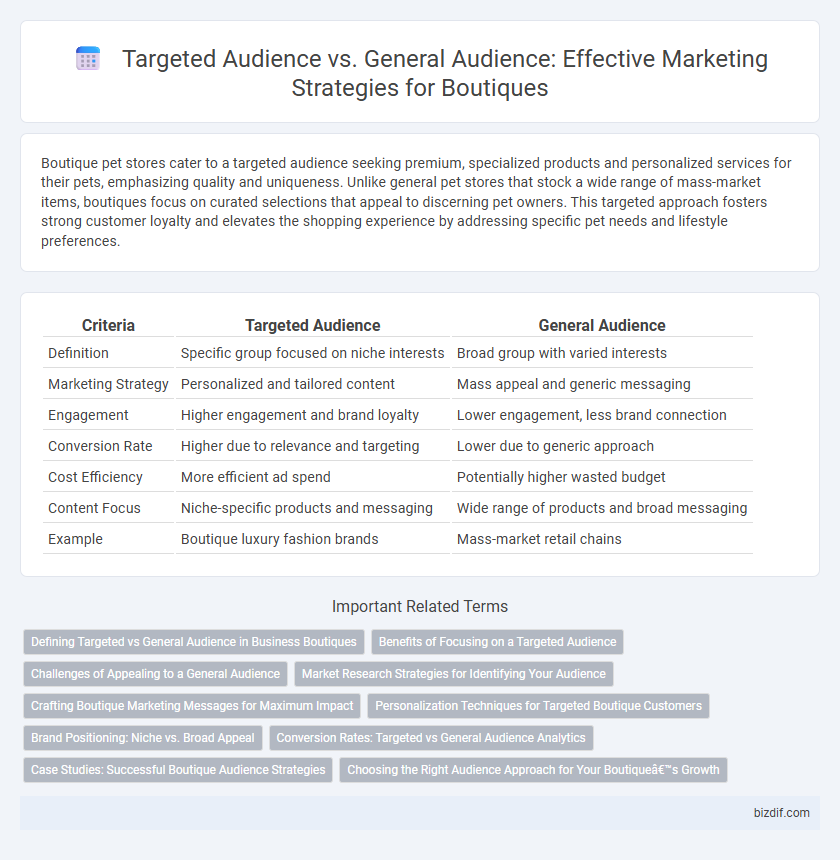Boutique pet stores cater to a targeted audience seeking premium, specialized products and personalized services for their pets, emphasizing quality and uniqueness. Unlike general pet stores that stock a wide range of mass-market items, boutiques focus on curated selections that appeal to discerning pet owners. This targeted approach fosters strong customer loyalty and elevates the shopping experience by addressing specific pet needs and lifestyle preferences.
Table of Comparison
| Criteria | Targeted Audience | General Audience |
|---|---|---|
| Definition | Specific group focused on niche interests | Broad group with varied interests |
| Marketing Strategy | Personalized and tailored content | Mass appeal and generic messaging |
| Engagement | Higher engagement and brand loyalty | Lower engagement, less brand connection |
| Conversion Rate | Higher due to relevance and targeting | Lower due to generic approach |
| Cost Efficiency | More efficient ad spend | Potentially higher wasted budget |
| Content Focus | Niche-specific products and messaging | Wide range of products and broad messaging |
| Example | Boutique luxury fashion brands | Mass-market retail chains |
Defining Targeted vs General Audience in Business Boutiques
Business boutiques define targeted audiences as specific customer groups characterized by distinct demographics, preferences, and purchasing behaviors, enabling personalized marketing strategies. In contrast, general audiences encompass broader, less segmented populations with diverse needs, often resulting in wider but less tailored outreach efforts. Focusing on a targeted audience allows boutiques to optimize product offerings and communication, driving higher engagement and conversion rates.
Benefits of Focusing on a Targeted Audience
Focusing on a targeted audience allows boutiques to tailor their merchandise, marketing strategies, and customer experiences to specific consumer preferences, resulting in higher engagement and loyalty. This approach enhances the boutique's ability to offer unique, relevant products that meet the exact needs of their niche market, increasing conversion rates and customer satisfaction. By concentrating resources on a defined segment, boutiques can optimize inventory management and reduce marketing costs while building a strong brand identity within their chosen demographic.
Challenges of Appealing to a General Audience
Appealing to a general audience in a boutique setting often dilutes the brand's unique value proposition, making it difficult to create personalized experiences that resonate deeply with specific customer segments. Broad targeting increases marketing costs and reduces the effectiveness of messaging, as it fails to address the nuanced preferences and behaviors of niche clientele. This lack of focused engagement results in lower customer loyalty and weaker brand identity compared to targeted campaigns designed for defined audiences.
Market Research Strategies for Identifying Your Audience
Market research strategies for identifying your audience in a boutique setting involve segmenting demographics, psychographics, and purchasing behaviors to pinpoint a targeted audience. Employing surveys, customer interviews, and data analytics helps distinguish the specific needs of boutique shoppers versus a general audience, optimizing product selection and marketing outreach. Leveraging niche preferences and local market trends enhances customer engagement and drives boutique sales growth.
Crafting Boutique Marketing Messages for Maximum Impact
Crafting boutique marketing messages requires a deep understanding of the targeted audience's preferences, lifestyle, and values to ensure maximum emotional resonance and brand loyalty. Tailoring content with specific language, visuals, and offers designed for niche groups outperforms generic messaging aimed at a general audience, which often lacks personalization and fails to engage effectively. Data-driven insights about customer demographics and purchasing behavior enhance the precision of boutique campaigns, resulting in higher conversion rates and sustained customer relationships.
Personalization Techniques for Targeted Boutique Customers
Boutiques thrive by employing advanced personalization techniques that cater specifically to targeted audiences, such as tailored product recommendations, exclusive collections, and individualized customer service. Unlike general audience approaches, personalization enhances customer engagement by using data analytics and behavioral insights to predict preferences and increase purchase likelihood. Implementing personalized marketing campaigns and customized shopping experiences drives higher conversion rates and fosters brand loyalty among boutique clientele.
Brand Positioning: Niche vs. Broad Appeal
Boutiques thrive by targeting a niche audience that values exclusive, high-quality products tailored to specific tastes, enhancing brand positioning through curated offerings and personalized experiences. This targeted approach distinguishes boutique brands from those with broad appeal, which focus on mass-market accessibility and standardized product lines. Emphasizing niche market segments allows boutiques to build strong customer loyalty and perceived brand value, essential for sustaining competitive advantage in luxury and specialty retail sectors.
Conversion Rates: Targeted vs General Audience Analytics
Targeted audiences in boutique marketing generate significantly higher conversion rates, often exceeding general audience engagement by up to 40%, due to personalized messaging and tailored product offerings. Analytics reveal that targeted campaigns optimize ad spend by focusing on niche demographics, increasing ROI through precise customer profiling and behavior tracking. General audience strategies yield broader reach but result in lower conversion efficiency, highlighting the critical role of data-driven segmentation for boutique success.
Case Studies: Successful Boutique Audience Strategies
Boutiques that tailor marketing strategies to targeted audiences outperform those using general audience approaches by 30% in customer engagement and conversion rates, as shown in case studies from brands like Everlane and Aesop. These case studies emphasize personalized messaging, exclusive product offerings, and localized digital campaigns that resonate deeply with niche market segments. Leveraging customer data analytics and behavioral insights enables boutiques to refine audience targeting, resulting in higher lifetime value and brand loyalty.
Choosing the Right Audience Approach for Your Boutique’s Growth
Identifying a targeted audience allows boutiques to tailor product selections and marketing strategies, enhancing customer engagement and loyalty, which drives sustainable growth. Understanding specific consumer behaviors and preferences in niches such as luxury fashion or eco-conscious buyers enables more efficient use of marketing budgets compared to a general audience approach. Boutique owners who focus on precise demographics achieve higher conversion rates and brand differentiation in competitive markets.
Targeted Audience vs General Audience Infographic

 bizdif.com
bizdif.com